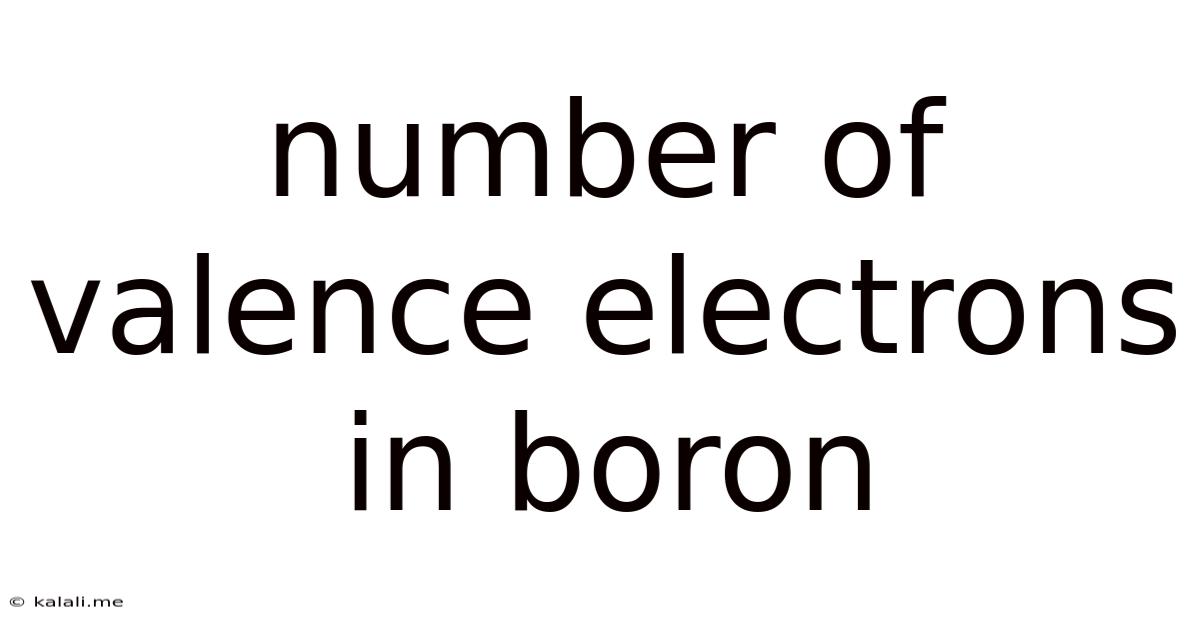Number Of Valence Electrons In Boron
Kalali
Jun 11, 2025 · 3 min read

Table of Contents
Unveiling the Mystery: How Many Valence Electrons Does Boron Possess?
Boron, a metalloid element crucial in various applications from semiconductors to detergents, presents an interesting case study when discussing valence electrons. Understanding its valence electron configuration is key to comprehending its chemical behavior and bonding properties. This article will delve into the specifics of boron's electron configuration and explain why it has the number of valence electrons it does.
What are Valence Electrons?
Before jumping into boron's specifics, let's clarify what valence electrons are. Valence electrons are the electrons located in the outermost shell (or energy level) of an atom. These electrons are the ones involved in chemical bonding with other atoms. The number of valence electrons dictates an element's reactivity and the types of bonds it can form – ionic, covalent, or metallic. Understanding valence electrons is fundamental to predicting chemical properties and reactions.
Boron's Electronic Configuration and Valence Electrons
Boron (B) has an atomic number of 5, meaning it has 5 protons and 5 electrons in a neutral atom. To determine the number of valence electrons, we need to examine its electron configuration. Using the Aufbau principle and Hund's rule, boron's electron configuration is 1s²2s²2p¹.
- 1s²: This signifies two electrons in the first energy level (shell).
- 2s²: This indicates two electrons in the second energy level's s subshell.
- 2p¹: This shows one electron in the second energy level's p subshell.
The outermost shell for boron is the second energy level (n=2). Therefore, boron possesses a total of three valence electrons (two from the 2s subshell and one from the 2p subshell).
Boron's Chemical Behavior and its Three Valence Electrons
Boron's three valence electrons explain its chemical behavior. It's relatively reactive, although less so than elements with more valence electrons. This reactivity stems from its tendency to achieve a stable octet (eight electrons in its outermost shell) by either sharing its three valence electrons through covalent bonding or, less commonly, losing them to form a +3 cation (though this is energetically unfavorable).
Consequently, boron frequently forms covalent bonds, resulting in compounds like boron trifluoride (BF₃) and boric acid (H₃BO₃). The covalent bonds arise from the sharing of electrons to satisfy the octet rule for each atom.
Common Misconceptions about Boron's Valence Electrons
One common misconception is to incorrectly assume that the number of valence electrons is always equal to the group number on the periodic table. While this works for most main group elements, it’s crucial to remember that exceptions exist, particularly in the transition metals and elements that don't always follow the octet rule. Boron, despite being in Group 13, doesn’t readily form +3 ions in many compounds and instead prefers covalent bonding. Therefore, directly using group number alone to determine valence electrons can sometimes be misleading.
Conclusion:
Boron, with its atomic number 5 and electron configuration 1s²2s²2p¹, possesses three valence electrons. This number dictates its chemical properties, explaining its tendency towards covalent bonding and formation of compounds like BF₃ and H₃BO₃. Understanding valence electrons is vital in predicting the behavior and reactivity of elements, highlighting the importance of electron configuration in chemistry.
Latest Posts
Latest Posts
-
How Much Does Oil Weigh A Gallon
Jul 01, 2025
-
If I Was Born In 1977 How Old Am I
Jul 01, 2025
-
How Many Kisses Fit In A 32 Oz Jar
Jul 01, 2025
-
How Many Cups Are In 18 Oz
Jul 01, 2025
-
Do The Contestants On Naked And Afraid Get Paid
Jul 01, 2025
Related Post
Thank you for visiting our website which covers about Number Of Valence Electrons In Boron . We hope the information provided has been useful to you. Feel free to contact us if you have any questions or need further assistance. See you next time and don't miss to bookmark.